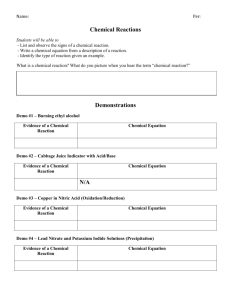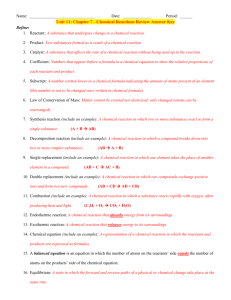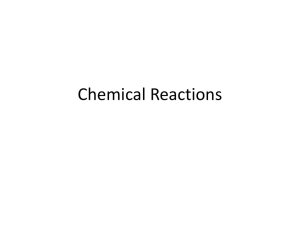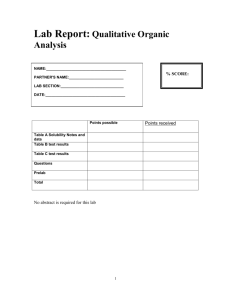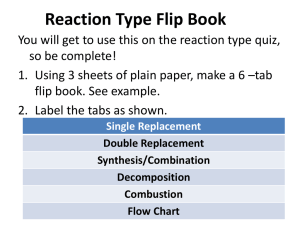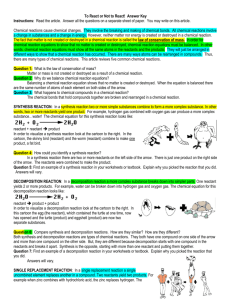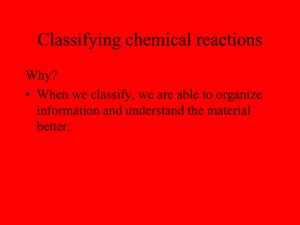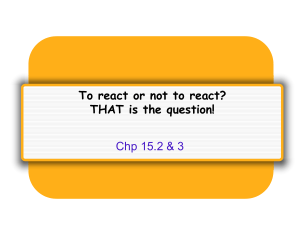Synthesis Reactions - Solon City Schools
advertisement
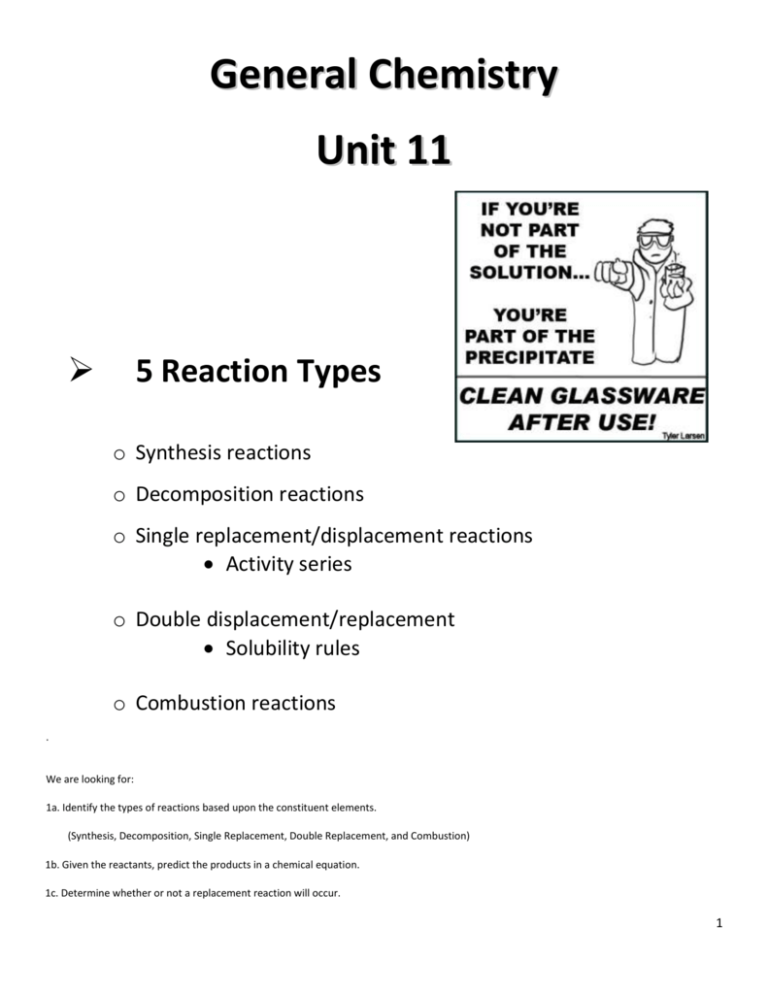
General Chemistry Unit 11 5 Reaction Types o Synthesis reactions o Decomposition reactions o Single replacement/displacement reactions Activity series o Double displacement/replacement Solubility rules o Combustion reactions . We are looking for: 1a. Identify the types of reactions based upon the constituent elements. (Synthesis, Decomposition, Single Replacement, Double Replacement, and Combustion) 1b. Given the reactants, predict the products in a chemical equation. 1c. Determine whether or not a replacement reaction will occur. 1 To react or not to react? THAT is the question! Chemical changes are a result of chemical reactions. All chemical reactions involve a change in substances and a change in energy. Neither matter or energy is created or destroyed in a chemical reaction---only changed. There are so many chemical reactions that it is helpful to classify them into 5 general types which include the following: SYNTHESIS REACTION In a synthesis reaction two or more simple substances combine to form a more complex substance. Two or more reactants yielding one product is another way to identify a synthesis reaction. For example, simple hydrogen gas combined with simple oxygen gas can produce a more complex substance----water! The chemical equation for this synthesis reaction looks like: reactant + reactant -------> product To visualize a synthesis reaction look at the following cartoon: In the cartoon, the skinny bird (reactant) and the worm (reactant) combine to make one product, a fat bird. DECOMPOSITION REACTION In a decomposition reaction a more complex substance breaks down into its more simple parts. One reactant yields 2 or more products. Basically, synthesis and decomposition reactions are opposites. For example, water can be broken down into hydrogen gas and oxygen gas. The chemical equation for this decomposition reaction looks like: reactant -------> product + product 2 To visualize a decomposition reaction look at the following cartoon: In this cartoon the egg (the reactant), which contained the turtle at one time, now has opened and the turtle (product) and egg shell (product) are now two separate substances. SINGLE REPLACEMENT REACTION In a single replacement reaction a single uncombined element replaces another in a compound. Two reactants yield two products. For example when zinc combines with hydrochloric acid, the zinc replaces hydrogen. The chemical equation for this single replacement reaction looks like: reactant + reactant ---------> product + product To visualize a single replacement reaction look at the following cartoon: Notice, the guy in the gray shirt steals the date of the other guy. So, a part of one of the reactants trades places and is in a different place among the products. 3 DOUBLE REPLACEMENT REACTION In a double replacement reaction parts of two compounds switch places to form two new compounds. Two reactants yield two products. For example when silver nitrate combines with sodium chloride, two new compounds--silver chloride and sodium nitrate are formed because the sodium and silver switched places. The chemical equation for this double replacement reaction looks like: reactant + reactant ---------> product + product To visualize a double replacement reaction look at the following cartoon: COMBUSTION REACTION A combustion reaction occurs when a compound containing carbon combines with the oxygen gas in the air. This process is commonly called burning. The products are always carbon dioxide and water. Here’s the equation that represents the burning of propane: C3H8 + O2 CO2 + H2O ENERGY OF CHEMICAL REACTIONS Chemical reactions always involve a change in energy. Energy is neither created or destroyed. Energy is absorbed or released in chemical reactions. Chemical reactions can be described as endothermic or exothermic reactions. Endothermic Reactions Chemical reactions in which energy is absorbed are endothermic. Energy is required for the reaction to occur. The energy absorbed is often heat energy or electrical energy. Adding electrical energy to metal oxides can separate them into the pure metal and oxygen. Adding electrical energy to sodium chloride can cause the table salt to break into its original sodium and chlorine parts. Exothermic Reactions Chemical reactions in which energy is released are exothermic. The energy that is released was originally stored in the chemical bonds of the reactants. Often the heat given off causes the product(s) to feel hot. Any reaction that involves combustion (burning) is an exothermic chemical reaction. 4 Types of Chemical Reactions Across 2. starting materials 9. anion trades one cation for another Down 1. new materials made 3. 2 cations and 2 anions switch partners 4. arrow means 5. has only one reactant 6. products are carbon dioxide and water 7. 2 small pieces make 1 new bigger piece 8. reaction where energy is absorbed 10. reaction where heat is made 5 Synthesis Reactions + __ elements or small compounds reacted together to make ____________________ Examples: Joining elements: __ + __ __ What is the oxidation number of Iron if sulfur has a -2 charge? ____ __Na + __Cl2 __NaCl Joining compounds: ___ CO2 + ___ H2O ___ C6H12O6 + ___O2 *** Synthesis reactions have one main purpose: 6 Synthesis Reactions Predict the products of these reactions and then balance the equations. 1. ___Mg + ___O2 → ___ 2. ___P4O10 + ___H2O 3. ___Fe (III) → ___H3PO4 + ___ I2 → ___ 4. ___H2 + ___Cl2 → ___ 5. Zinc + Sulfur → 6. Lead (IV) + Oxygen → 7. Potassium + Fluorine → 8. Hydrogen + Oxygen → 7 Synthesis: In this activity, you will be determining the mass of the reactants before a chemical reaction and the mass of the products after the reaction. Materials: 4) crucible 5) crucible tongs 6) ring stand with clay triangle 1) balance 2) Bunsen burner 3) Mg ribbon Procedure: 1) Determine the mass of the empty crucible and record in table 1. 2) Obtain a 6 in strip of Mg ribbon. Cut it into about 12 pieces and put the pieces into the crucible and determine the mass. Record in table 1. 3) Place the crucible on the clay triangle and slowly heat it with a “soft” blue flame for a minute. 4) Increase the heat gradually by adjusting the burner’s flame until the crucible is at the tip of the inner cone. 5) Once the Mg begins to react, wait about 1 minute and then turn off the burner. REMEMBER: DO NOT LOOK DIRECTLY AT THE LIGHT!!! 6) Allow the crucible to cool on the ring stand for 15-20 min. Then determine the mass of the product by weighing the crucible + product and subtracting the mass of the crucible. Record in table 1. Mass of Crucible Mass of reactant (Mg) Mass of product (?) Analysis: 1) Compare the mass of the reactant to the mass of the product by determining the % recovery: % recovery = (mass of product/mass of reactant) x 100 2) Write the balanced equation for the reaction that occurred. Be sure to include any inputs and outputs such as heat, chemical catalysts, energy, light, etc. Hint: Mg combined with oxygen. 8 Decomposition Reactions → + reactant ( ) forms or ( ) For decomposition reactions to occur – need energy: ● ● ● ● 9 Some compounds decompose readily, if formed in a reaction: H2CO3 = Carbonic Acid H2CO3(aq) → (l) + (g) H2SO3 = Sulfurous Acid H2SO3(aq) → (l) + (g) Verifying your products: If product is H2 o Use burning splint o Will hear a “ ” If product is O2 o Use glowing splint (blow it out) o Will 10 Decomposition of Water: ___H2O → ___H2 + ___O2 Gas = ____ Gas = ____ Proof: Proof: 11 Decomposition of Hydrogen Peroxide Decomposition: In this activity, you will be determining the products of the decomposition of hydrogen peroxide. Materials: 1) glass jar 2) pie plate 3) 125 ml Hydrogen peroxide 4) 100 ml graduated cylinder) 6) 100 ml warm water 5) Food coloring 10) stirring rod 7) 250 ml beaker 8) 7g yeast 9) weigh boat 11) wood splints Procedure: Group 1: 1. Place glass jar in center of pie plate. 2. Add 125 ml of hydrogen peroxide to the glass jar. 3. Add 4 drops of food coloring to glass jar – your choice! 4. Place pie plate with glass jar in center of lab station 5. Wait for further instructions Group 2: 1. Put 7 grams of yeast into 250 ml beaker 2. Add 100 mL warm water to same 250 ml beaker 3. Using stirring rod, stir yeast and warm water for 3-5 minutes 4. Wait for further instructions Analysis: Write the balanced equation for the reaction that occurred. Be sure to include any inputs and outputs such as heat, chemical catalysts, energy, light, etc. Hint: The yeast remains unchanged and one of the products is water. 12 Decomposition Reactions Determine the coefficients! 1. ____Na2CO3 → ____ Na2O + ____ CO2 2. ____ HgO → ____ Hg + ____O2 3. ____ NaCl → ____Na + ____ Cl2 4. ____ NH4NO3 → ____ N2O + ____ H2O 5. ____ KClO3 → ____ KCl + ____ O2 6. Silver (I) Oxide decomposes into Silver and Oxygen 7. Iron (III) Oxide decomposes into Iron and Oxygen 8. Calcium Carbonate decomposes into Calcium Oxide and Carbon Dioxide Bonus: ____(NH4)2Cr2O7 → ___ NH3 + ___H2O + ___Cr2O3 + ___O2 13 Single Replacement Reactions ** Single Displacement** + + A __________________ “A” displaces or switches places with a ___________________ “B” Example: 1. Fe + CuCl2 FeCl2 + Cu 2. Cu + AgNO3 Ag + Cu(NO3)2 3. Ca + H2O If A is ___________ than B, the reaction takes place! If A is _____________ than B, nothing happens!! 14 Single Replacement Activity 1. Use a spot plate to perform the following investigation. 2. Each kind of metal will be tested with 5 different solutions. Reactions will occur when the free metal is more reactive than the metal in the solution. No reaction will occur if the free metal is less reactive than the metal in the solution. 3. Place 1 piece of metal in each well. Add enough solution to completely cover the metal (10 to 20 drops). 4. Watch carefully…. Be Patient!!!! If a reaction occurs, place a in that box on the table and write the sign that indicates that there is a reaction taking place (Color, Gas, Precipitate). If a reaction does not occur – place an X in that square. Zn(NO3)2 Pb(NO3)2 MgSO4 CuSO4 Fe(NO3)3 CaCl2 Zn Pb Mg Cu Fe Ca 15 One last test, take a piece of copper (Cu) and test it with AgNO3 solution. Do you see a reaction? ________________ What does this result mean? _____________________ Conclusion: Below – Rank the metals from this activity based on their reactivity. Include silver (Ag) in the rankings! Most reactive metal Least reactive metal Clean-up: Dump the liquids and reacted metals on a paper towel (or two) and throw in the trash! Rinse the spot plate with water (Use a test tube brush to clean out the spots, if necessary) then place it upside down on some paper towels to dry. Thanks!! 16 Using the activity chart provided, predict whether or not the following reactions will take place. For the reactions that will occur, predict the products and then balance the reaction. = Go = No Go _____ 1. Al + Fe2O3 _____ 2. Pb + MgSO4 (Pb charge = +2) _____ 3. Zn + FeCl3 (Zn charge = +2) _____ 4. Fe + CuCl2 (Fe charge = +3) _____ 5. Ag + CuSO4 (Ag charge = +1) _____ 6. Au + AgBr (Au charge = +1) _____ 7. Cr + NiI2 (Cr charge = +2) _____ 8. K + MgSO4 _____ 9. Zn + MgCl2 (Zn charge = +2) _____ 10. Na + CaSO4 17 Activity Series Metals Lithium,Li Potassium, K Calcium, Ca Sodium, Na Magnesium, Mg Aluminum, Al Zinc, Zn Chromium, Cr Iron, Fe Nickel, Ni Tin, Sn Lead, Pb Hydrogen, H Copper, Cu Mercury, Hg Silver, Ag Platinum, Pt Gold, Au Decreasing Activity Halogens fluorine, F chlorine, Cl bromine, Br iodine, I 18 More Single Replacement practice: 1. ___Al + ___CuCl2 2. ___ Br2 + ___CaI2 3. ___ Zn + ___H2SO4 4. ___ Br2 + ___CaI2 5. ___ Al + ___Pb(NO3)2 6. ___ Cl2 + ___KI 7. ___ Ag + ___KNO3 8. ___ F2 + ___NaI 19 Double Replacement (or Double Displacement) AB + CD → AD + CB Both pairs change partners – Always write positive ion (cation) first For Products: Formulas can and will change Look up charges for each ion Do 1 to 1 or criss cross Once formulas are adjusted: Take inventory of reactants and products Balance equation Example: Potassium Iodide + Lead (II) Nitrate → K I + Pb (NO3) → 20 A double replacement reaction will occur IF: Water forms A gas forms o H2CO3 immediately breaks down It forms CO2 + H2O CO2 is a gas o Other gases: H2, O2, N2, Cl2, F2 A precipitate forms (Use solubility table) o If a compound is soluble – it is not a sign that the reaction will go). o A precipitate is insoluble – it is evidence that the reaction will go. 21 Ion Solubility Rules *For Double Replacement/Displacement Reactions* 1. All compounds containing alkali metals (Li+, Na+, K+, Rb+, Cs+) or ammonium (NH4+) are soluble. 2. All nitrates (NO3-), acetates (C2H3O2-), and chlorates (ClO3-) are soluble. 3. All metal ions combined with the halogens (Cl-, Br-, I-, F-) are soluble, except for Hg, Ag, and Pb. 4. All sulfates (SO42-) are soluble, except for Ca, Ba, Sr, and Hg, Ag, and Pb. 5. Except for rule #1, all carbonate (CO32-), chromates (CrO42-), hydroxides (OH-), oxides (O2-), phosphates (PO43-) and sulfides (S2-) are insoluble. 22 Predicting Products and Solubility Rules Practice: CaCl2 Pb(NO3)2 AgC2H3O2 FeF2 Na2CO3 Rb3PO4 K2SO4 NH4Br Li2S 23 Write the complete chemical equation and balance it for each of the six reactions. 1. Sodium Carbonate + Hydrogen Chloride → Product 1 and Product 2 Using the Solubility Chart: Product 1 = __________ Product 2 = __________ Is it soluble? Yes or No Is it soluble? Yes or No If either Product 1 or 2 is not soluble, the reaction will take place! Mix 2 milliliters of each reactant together; make observations: Did the reaction really take place? What chemical signs were present to indicate that a reaction took place? ____________________________________________________________ 2. Hydrogen Chloride + Sodium Hydroxide → Product 1 and Product 2 Using the Solubility Chart: Product 1 = __________ Product 2 = __________ Is it soluble? Yes or No Is it soluble? Yes or No If either Product 1 or 2 is not soluble, the reaction will take place! Mix 2 milliliters of each reactant together; make observations: Did the reaction really take place? What chemical signs were present to indicate that a reaction took place? ____________________________________________________________ 24 3. Barium Nitrate + Sodium Sulfate → Product 1 and Product 2 Using the Solubility Chart: Product 1 = __________ Product 2 = __________ Is it soluble? Yes or No Is it soluble? Yes or No If either Product 1 or 2 is not soluble, the reaction will take place! Mix 2 milliliters of each reactant together; make observations: Did the reaction really take place? What chemical signs were present to indicate that a reaction took place? ____________________________________________________________ 4. Lead (II) Nitrate + Sodium Chloride → Product 1 and Product 2 Using the Solubility Chart: Product 1 = __________ Product 2 = __________ Is it soluble? Yes or No Is it soluble? Yes or No If either Product 1 or 2 is not soluble, the reaction will take place! Mix 2 milliliters of each reactant together; make observations: Did the reaction really take place? What chemical signs were present to indicate that a reaction took place? ____________________________________________________________ 25 5. Ammonium Chloride + Sodium Hydroxide → Product 1 and Product 2 Using the Solubility Chart: Product 1 = __________ Product 2 = __________ Is it soluble? Yes or No Is it soluble? Yes or No If either Product 1 or 2 is not soluble, the reaction will take place! Mix 2 milliliters of each reactant together; make observations: Did the reaction really take place? What chemical signs were present to indicate that a reaction took place? ____________________________________________________________ 6. Lead (II) Nitrate + Potassium Chromate → Product 1 and Product 2 Using the Solubility Chart: Product 1 = __________ Product 2 = __________ Is it soluble? Yes or No Is it soluble? Yes or No If either Product 1 or 2 is not soluble, the reaction will take place! Mix 2 milliliters of each reactant together; make observations: Did the reaction really take place? What chemical signs were present to indicate that a reaction took place? ____________________________________________________________ 26 Double Replacement Reactions Predict the products. Predict if these reactions will go to completion using the solubility rules. Indicate whether each product is soluble (aq) or insoluble (s). 1. ___ NaOH(aq) + ___ CaBr2 (aq) Will this reaction occur? _____ 2. ___ Pb(NO3)2 (aq) + ___ HCl (aq) Will this reaction occur? _____ 3. ___ Na2(CO3) (aq) + ___ KF (aq) Will this reaction occur? _____ 4. ___ Ag(NO3) (aq) + ___ Cu(SO4) (aq) Will this reaction occur? _____ 5. ___ LiF (aq) + ___ NiCl2 (aq) Will this reaction occur? _____ 27 Combustion Reactions + + **One reactant needs _________________ ** **The other _________________________** The products are always ______+ ______. ___________________ are always exothermic (They give off _____________________!) Examples: ___CH4 + ___ O2 ___CO2 + ___H2O ___C4H10 + O2 ___CO2 + ___H2O The CxHy reactant can also contain _________: (CxHyOz) 2CH3OH + 3O2 2CO2 + 4H2O 28 Combustion Reactions Complete the Reactions and Balance! 1. ___CH4 + ___O2 2. ___C3H8 + ___O2 3. ___C8H18 + ___O2 4. ___C6H12O6 + ___O2 5. ___C6H6 + ___O2 6. ___C2H6 + ___O2 7. ___CH3OH + ___O2 8. ___C3H7OH + ___O2 9. ___C8H17OH + ___O2 10 ___C6H5OH + ___O2 29 Classification of Chemical Reactions A + B AB A + BC AB Synthesis A + B Decomposition B + AC Single Replacement AB + CD AD + CB Double Replacement CxHy + O2 CO2 + H2O Combustion 30 ??? WHAT KIND OF REACTION ??? 1. Ca + O2 2. HgO 3. Cd + HCl 4. MnSO4 MnO + SO3 5. Al + Cl2 6. FeCl2 + Na3PO4 7. Mg + CuSO4 8. NaNO3 NaNO2 + O2 9. Mg + N2 10. O2 + C2H6 31 Types of Reactions Worksheet For each reaction: balance and predict reaction type . 1. ___NaBr + ___H3PO4 → ___Na3PO4 + ___HBr Type of Reaction: __________________________ 2. ___Mg + ___Cr2O3 → ___Cr + ___MgO Type of Reaction: __________________________ 3. ___Fe + ___Cl2 → ___FeCl3 Type of Reaction: __________________________ 4. ___CaS → ___Ca + ___S8 Type of Reaction: __________________________ 5. ___Pb + ___HCl → ___PbCl2 + ___H2 Type of Reaction: __________________________ 32 6. ___H2SO4 + ___NH4OH → ___H2O + ___(NH4)2SO4 Type of Reaction: __________________________ 7. ___HgO → ___Hg + ___O2 Type of Reaction: __________________________ 8. ___Rb + ___P4 → ___Rb3P Type of Reaction: __________________________ 9. ___C6H14 + ___O2 → ___CO2 + ___H2O Type of Reaction: __________________________ 33 Fun with Predicting Reaction Products 1) ___Ag2SO4 + ____ NaNO3 2) ___NaI + ___ CaSO4 3) ___HNO3 + ___ Ca(OH)2 4) ___ CaCO3 5) ___AlCl3 + ___ (NH4)PO4 6) ___Pb + ___ Fe(NO3)3 7) ___C3H6 + ___ O2 34 8) ___Na + ___ CaSO4 9) ____Na + ____O2 10) ____C4H10 + ____O2 11) ____BrF3 12) ____C8H18 + ____O2 13) ____Sb + ____I2 14) ____Al2O3 35

